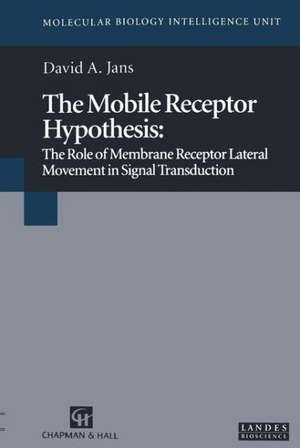The Mobile Receptor Hypothesis: The Role of Membrane Receptor Lateral Movement in Signal Transduction: Molecular Biology Intelligence Unit
Autor David A. Jansen Limba Engleză Paperback – 24 dec 2012
Din seria Molecular Biology Intelligence Unit
- 5%
 Preț: 663.60 lei
Preț: 663.60 lei - 18%
 Preț: 1229.10 lei
Preț: 1229.10 lei - 5%
 Preț: 1091.14 lei
Preț: 1091.14 lei - 24%
 Preț: 775.98 lei
Preț: 775.98 lei - 18%
 Preț: 1226.60 lei
Preț: 1226.60 lei - 15%
 Preț: 642.51 lei
Preț: 642.51 lei - 5%
 Preț: 1098.48 lei
Preț: 1098.48 lei - 15%
 Preț: 638.11 lei
Preț: 638.11 lei - 18%
 Preț: 944.99 lei
Preț: 944.99 lei - 5%
 Preț: 716.09 lei
Preț: 716.09 lei - 20%
 Preț: 552.98 lei
Preț: 552.98 lei - 5%
 Preț: 1096.62 lei
Preț: 1096.62 lei - 5%
 Preț: 1097.71 lei
Preț: 1097.71 lei - 18%
 Preț: 942.94 lei
Preț: 942.94 lei - 18%
 Preț: 1222.49 lei
Preț: 1222.49 lei - 5%
 Preț: 1408.97 lei
Preț: 1408.97 lei - 18%
 Preț: 947.04 lei
Preț: 947.04 lei - 5%
 Preț: 1094.60 lei
Preț: 1094.60 lei - 18%
 Preț: 945.79 lei
Preț: 945.79 lei - 24%
 Preț: 1053.39 lei
Preț: 1053.39 lei - 24%
 Preț: 786.18 lei
Preț: 786.18 lei - 24%
 Preț: 789.89 lei
Preț: 789.89 lei - 18%
 Preț: 945.62 lei
Preț: 945.62 lei - 5%
 Preț: 1095.90 lei
Preț: 1095.90 lei - 5%
 Preț: 1429.27 lei
Preț: 1429.27 lei - 24%
 Preț: 817.70 lei
Preț: 817.70 lei - 5%
 Preț: 1104.84 lei
Preț: 1104.84 lei - 18%
 Preț: 947.85 lei
Preț: 947.85 lei - 15%
 Preț: 640.88 lei
Preț: 640.88 lei - 18%
 Preț: 951.29 lei
Preț: 951.29 lei - 5%
 Preț: 1095.73 lei
Preț: 1095.73 lei - 18%
 Preț: 950.33 lei
Preț: 950.33 lei - 18%
 Preț: 946.55 lei
Preț: 946.55 lei - 18%
 Preț: 952.89 lei
Preț: 952.89 lei - 5%
 Preț: 714.63 lei
Preț: 714.63 lei - 18%
 Preț: 946.41 lei
Preț: 946.41 lei - 18%
 Preț: 947.85 lei
Preț: 947.85 lei - 18%
 Preț: 956.03 lei
Preț: 956.03 lei - 5%
 Preț: 1293.02 lei
Preț: 1293.02 lei - 5%
 Preț: 1098.63 lei
Preț: 1098.63 lei - 18%
 Preț: 944.19 lei
Preț: 944.19 lei - 18%
 Preț: 950.52 lei
Preț: 950.52 lei - 24%
 Preț: 782.70 lei
Preț: 782.70 lei - 18%
 Preț: 953.65 lei
Preț: 953.65 lei - 15%
 Preț: 640.06 lei
Preț: 640.06 lei - 5%
 Preț: 1610.67 lei
Preț: 1610.67 lei - 18%
 Preț: 947.35 lei
Preț: 947.35 lei - 18%
 Preț: 1231.32 lei
Preț: 1231.32 lei - 15%
 Preț: 649.06 lei
Preț: 649.06 lei - 18%
 Preț: 1231.16 lei
Preț: 1231.16 lei
Preț: 365.10 lei
Preț vechi: 384.31 lei
-5% Nou
Puncte Express: 548
Preț estimativ în valută:
69.86€ • 73.28$ • 58.16£
69.86€ • 73.28$ • 58.16£
Carte tipărită la comandă
Livrare economică 01-15 aprilie
Preluare comenzi: 021 569.72.76
Specificații
ISBN-13: 9781475706826
ISBN-10: 1475706820
Pagini: 240
Ilustrații: XI, 224 p.
Dimensiuni: 152 x 229 x 13 mm
Greutate: 0.33 kg
Ediția:Softcover reprint of the original 1st ed. 1997
Editura: Springer Us
Colecția Springer
Seria Molecular Biology Intelligence Unit
Locul publicării:New York, NY, United States
ISBN-10: 1475706820
Pagini: 240
Ilustrații: XI, 224 p.
Dimensiuni: 152 x 229 x 13 mm
Greutate: 0.33 kg
Ediția:Softcover reprint of the original 1st ed. 1997
Editura: Springer Us
Colecția Springer
Seria Molecular Biology Intelligence Unit
Locul publicării:New York, NY, United States
Public țintă
ResearchCuprins
1. Introduction to the Mobile Receptor Hypothesis.- A. The Fluid Mosaic Model of Biological Membranes.- B. The Mobile Receptor Hypothesis.- C. Modern Collision Coupling Theory.- D. Summary and Implications.- 2. Direct Measurement of Lateral Mobility.- A. Introduction.- B. Fluorescence Microscopy.- C. Confocal Microscopy.- D. Fluorescence Photobleaching Recovery.- E. Lateral Mobility in the Cytoplasm and Membranes of Living Cells.- F. Measurements in Artificial and Isolated Membranes.- G. Measurements of Lateral Mobility Using Other Methods.- H. Summary.- 3. Parameters Affecting Plasma Membrane Protein Lateral Mobility.- A. Mechanisms of Protein Immobilization in Biological Membranes.- B. Membrane Lipid Mobility.- C. The Cytoskeleton.- D. Anchorage Modulation.- E. Membrane Protein Sequence Motifs.- F. Domain Structure: Regions of Restricted Mobility.- G. Signal Transduction.- H. Summary.- 4. Lateral Mobility of Polypeptide Hormone Receptors and GTP-Binding Proteins.- A. Introduction.- B. Practical Considerations.- C. Lateral Mobility Measurements of Polypeptide Hormone Receptors.- D. Tyrosine Kinase Receptor-Mediated Signal Transduction.- E. GTP-Binding Protein Activating Receptor-Mediated Signal Transduction.- F. Structural Considerations.- G. Lateral Mobility Measurements of GTP-Binding Proteins.- H. Lateral Mobility of Cytokine Receptors.- I. Summary and Implications for Signal Transduction.- 5. Evidence for the Role of Membrane Receptor Lateral Movement in GTP-Binding Protein-Mediated Signal Transduction.- A. Introduction.- B. Kinetic Considerations in GTP-Binding Protein-Mediated Receptor-Effector Systems.- C. Indirect Evidence for a Role of Receptor Lateral Movement in GTP-Binding Protein-Mediated Signal Transduction.- D. Direct Evidence for a Role of Receptor Lateral Movement in GTP-Binding Protein-Mediated Signal Transduction.- E. Ga Signaling in the Cytosolic Phase.- F. Stoichiometric Considerations and Trimeric GTP-Binding Protein Immobility.- G. Amplification in GTP-Binding Protein-Mediated Receptor-Effector Systems Through Receptor Lateral Movement.- H. Summary.- 6. Evidence for the Role of Receptor Immobilization in Desensitization Subsequent to Hormonal Stimulation.- A. Introduction.- B. Receptor Internalization in Desensitization of Response.- C. Receptor Immobilization Prior to Internalization.- D. Receptor Movement Required for Internalization.- E. Kinetic Considerations with Respect to Lateral Mobility Measurements.- F. Receptor Phosphorylation.- G. Studies with Receptor Antagonists—Receptor Immobilization Is Agonist-Dependent.- H. Summary.- 7. Evidence for the Role of Immobilization of Ligand-Occupied Membrane Receptors in Signal Transduction.- A. Introduction.- B. Receptor Immobilization in Tyrosine Kinase Receptor Signaling.- C. Receptor Immobilization in Signaling by Fc Receptors.- D. Receptor Immobilization in Cell-Cell Interaction.- E. Receptor Immobilization in Cell-Adhesion to an Extracellular Substratum.- F. Summary.- 8. The Mobile Receptor Hypothesis: A Global View.- A. Introduction.- B. Receptor Lateral Movement in Signal Transduction.- C. The Central Role of the Cytoskeleton.- D. Signal Transduction: Receptor Lateral Mobility Modulation by Heterologous Signaling.- E. Potential Pharmacological Applications of the Mobile Receptor Hypothesis.- F. Concluding Remarks.







